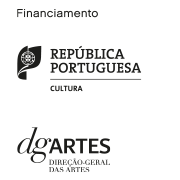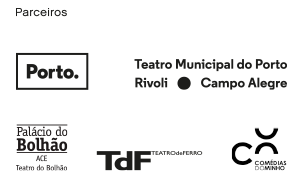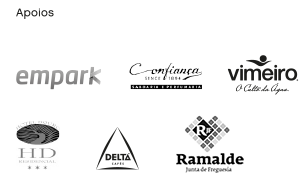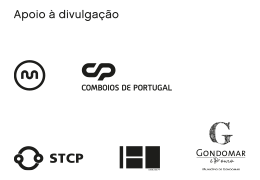The Ventriloquists Convention
Gisèle Vienne, Dennis Cooper and Puppentheater Halle
22nd Oct, 9:30pm
Teatro Rivoli – Grande Auditório Manoel de Oliveira
120' · M12
Post-Show Talk
With Joana Manarte
Voice coach; voice therapist/teacher; singer.
Concept, direction and scenography Gisèle Vienne
Text Dennis Cooper, in collaboration with the performers
Music KTL (Stephen O'Malley, Peter Rehberg)
Light Patrick Riou
Performed and created in collaboration with Jonathan Capdevielle, Kerstin Daley-Baradel, Uta Gebert & Vincent Göhre and the perfomers of Puppentheater, Halle: Nils Dreschke, Sebastian Fortak, Lars Frank, Ines Heinrich-Frank, Katharina Kummer.
Translation Jean-René Etienne
Accessories, scenography and costumes Gisèle Vienne, in collaboration with Angela Baumgart
Stage and scenography assistant Yana Zschiedrich
Stage assistant on tour Anne Mousselet
Puppets conception Gisèle Vienne
Puppets making Hagen Tilp
Make up and wigs for Jonathan Capdevielle Mélanie Gerbeaux
Kerstin Daley-Baradel's costume designed by José Enrique Oña Selfa
Ventriloquy workshop I Marcus Geuss
Ventriloquy workshop II Michel Déjeneffe
Technical direction projet Henryk Drewniok
Technical direction Puppentheater Halle Daniel Schreiner Technical coordination & light manager Arnaud Lavisse
Sound Engineer Mattef Kuhlmey
Project manager halle Katja Podzimski
Production & booking DACM Anne-Lise Gobin, Alix Sarrade & Fréderique Vansteenwegen
Administration Etienne Hunsinger
Thanks Laure Fernandez, Carena Schlewitt, Vent Haven Museum and Vent Haven Convention, Francesca Spinazzi, Zac Farley, Jean-Paul Vienne, Dorothéa Vienne-Pollak.
Production Puppentheater Halle and DACM (Halle / Saale & Strasbourg)
Co-production Nanterre-Amandiers – centre dramatique national, Festival d'Automne à Paris, Les Spectacles Vivants - Centre Pompidou, Centre Dramatique National Orléans/Loiret/Centre, Le TJP, Centre Dramatique National d'Alsace - Strasbourg, Le Maillon, Théâtre de Strasbourg - Scène européenne, La Bâtie, Festival de Genève, Internationales Sommerfestival, Kampnagel, Hamburg, Kaserne Basel, Le Parvis, Scène nationale de Tarbes - Pyrénées, Theater Freiburg, Bonlieu, Scène nationale d'Annec, hTh CDN de Montpellier, Fidena Festival - Bochum
With the support of Kulturstiftung des Bundes, Pro Halle e.V., Saalesparkasse, FachausschussTanz und Theater Basel - Stadt / Basel – Landschaft, Institut Français in the frame of « Théâtre export », Bureau Théâtre et Danse - Institut Français d'Allemagne & Association Beaumarchais-SACD Paris in the frame of the help program in production, Cultural Services of the French Embassy New-York
The Company Gisèle Vienne is supported by Ministère de la culture et de la communication – DRAC Alsace- Champagne-Ardenne-Lorraine, la Région Alsace - Champagne-Ardenne - Lorraine, Ville de Strasbourg, and Service de la culture du Canton de Bâle-Ville.
The company is supported by Institut Français – Ministère des affaires étrangères, for international touring.

Gisèle Vienne is associate artist at the Nanterre-Amandiers CDN since 2014
www.g-v.fr/
denniscooper-theweaklings.blogspot.fr
buehnen-halle.de/puppentheater
Gisele Vienne's working notes – January 2014
Each year, the state of Kentucky hosts the biggest global convention of ventriloquists in the world. The Convention takes place next to the Vent Haven Museum, a venue dedicated to the art of ventriloquism which is also a cemetery of sorts: this is where puppets who no longer perform on stage – often after the death of their owner – come to be kept and exhibited. The Convention is an opportunity for ventriloquists from all over the United States, and the rest of the world, to meet, network, make friends, and build professional relationships. Ventriloquists from very different social and professional backgrounds come here to find like-minded peers and share a common passion that is seen as unusual and sometimes downright odd by others.
Research for "The Ventriloquists Convention" has led us to look at ventriloquists-cum- puppeteers, focusing on real-life material primarily related to the Kentucky event, as well as fictional sources.
The play specifically deals with the reasons why ventriloquists do what they do, what originally led them to take up ventriloquism, the way their work is viewed by others, as well as issues related to their gender and/or identity, and many other aspects of these curious characters.
This research also allowed us to examine the puppeteer and/or ventriloquist figure in a more generic way, as it is most commonly viewed in our psyche, and its various fictional representations, including those in films and literature. We looked at the recurrent characteristics of a character who is often seen as suspicious, strange, or even disturbing.
"The Ventriloquists Convention" is a highly realistic fictional work, an imagined reconstruction of the real-life, Kentucky-based annual event. Nine puppeteers-cum-ventriloquists will perform a play based on the various phases of the Convention, and take a look at the various challenges, both private and professional, facing them in their work and in the performance of their act. In a venue where multiple chairs, intended to welcome the convention's delegates, are arranged in a simple fashion, spectators share the same perspective as ventriloquists, and feel like they are themselves part of the convention's delegates.
The play, at first, may appear relatively simple; but it builds up as would a score, based on the manifold voices of characters whose psychological complexity is slowly revealed by their multi-layered dialogues.
Conversations between characters slowly grow from multiple voices: the voice of the ventriloquist him/herself – whether in character or not –, the voice of the puppet, and the more unusual ventriloquist "third voice" as we like to call it, devoid of any physical medium to actually carry that voice, which makes it seem disembodied. Every voice, whether natural or artificial, is unique, and easily distinguishable from other voices by its tone and by the "body" it is related to. If it is easy to accept the dramatic convention by which several characters may exist under the guise of a single physical person - the ventriloquist -, these voices subtly but firmly highlight and reveal the different facets of the ventriloquist's personality.
Dialogues then develop based on these multiple voices, while we remain aware of this schizophrenic dichotomy. Given the context, it seems realistic and natural that the puppets should speak to each other and address their own or other ventriloquists, that the "third voice" emanating from the ventriloquist but without physical medium is aimed at ventriloquists or puppets, and that all these voices from different sources converse among themselves.
The dialogue's various layers – i.e., what is said, what is thought, what comes from our unconscious – are therefore expressed aloud and in turns by the ventriloquist, his puppet or the third voice. Yet still, in the context of a ventriloquists' meeting, expressing out loud all of the language's layers that make up these conversations seems entirely natural despite what it may reveal about the characters, their privacy, and their relationships with others.
In a play where the performance is based on these various layers of dialogue, with their unspoken subtext, being uttered aloud, we can suddenly see both the madness and the normality of these conversations and the shift from seemingly uncomplicated relations to a real psychological maze.
Dennis Cooper wrote a particularly complex and distinctive dialogue for this unique play that encompasses a minimum of 27 voices performed by nine different puppeteers-cum- ventriloquists.
This performance is a continuation of our work on the multifaceted relationship between the body and the voice, through various embodiments and disembodiments of voices that allow us to examine our multi-layered psyche, as well as the importance of the chosen words within these multiple layers from a collective and individual point of view.
Gisèle Vienne was born in 1976, she is a franco-austrian artist, choreographer and director. After graduating in Philosophy, she studied at the puppeteering school EcoleSupérieureNationale des Arts de la Marionnette. There she met Etienne Bideau-Rey with whom she created her first shows.
She works regularly with, amongs other, the writers Dennis Cooper and Catherine Robbe- Grillet, the musicians Peter Rehberg and Stephen O'Malley, the light designer Patrick Riou and the actor Jonathan Capdevielle. Since 2004, she has choreographed and directed, in collaboration with the writer Dennis Cooper, I Apologize (2004) and Une belle enfant blonde / A young, beautiful blond girl (2005), Kindertotenlieder (2007) and Jerk, a radioplay in the framework of the "atelier de creation radiophonique" of France Culture (June 2007), the play Jerk (2008), This is how you will disappear (2010), LAST SPRING: A Prequel (2011) and The Pyre (2013). In 2009, she created EternelleIdole with an ice skater and an actor and the rewriting of Showroomdummies with Etienne Bideau-Rey. The same year she rewrites Showroomdummies with Etienne Bideau-Rey and in 2013 they rewrite it again for CCN- Ballet de Lorraine. Since 2005, she has been frequently exhibiting her photographs and installations.
Gisèle Vienne, Dennis Cooper, Peter Rehberg and Jonathan Capdevielle published an audio book in 2 versions French and English: JERK / Through Their Tears (publisher DIS VOIR). She has published a book 40 PORTRAITS 2003-2008, in collaboration with Dennis Cooper and Pierre Dourthe (publisher: P.O.L). The current work in progress is a piece for 15 dancers which will be premiered in November 2017.
Dennis Cooper is a novelist, poet and critic. He lives in Paris and Los Angeles. He has published ten novels, most recently Zac's Haunted House (a novel composed of animated gifs) in January 2015. He recently completed a feature film, Like Cattle Towards Glow, which he created in collaboration with the artist Zac Farley.
He is a contributing Editor of Artforum Magazine and the editor of the American publishing imprint Little House on the Bowery.
Collaborating with Gisele Vienne since 2004 he has written all the texts in I Apologize (2004), Kindertotenlieder(2007), Jerk (2008), This is how you will disappear (2010), LAST SPRING : A Prequel (2011), The Pyre (2013), The Ventriloquists Convention and Une enfant blonde. A Young Beautiful blonde girl (2006), in collaboration with Catherine Robbe-Grillet.
The Puppentheater Halle is a group of 8 permanent puppeteers and belongs to the TheaterOper und Orchester GmbH Halle. Each member has been trained at the theater school "Ernst Busch" in Berlin. Some of them are also directors, teachers or puppet makers. After a performance of the Puppentheater Halle in Paris, Brigitte Salino wrote in Le Monde : "The show is called « Buddenbrooks » and comes from Halle, a former city in East Germany known for its PuppetTheater. Created in 1954, Christoph Werner brought a new dynamic in 1995 by letting aside the traditional practice for a new style."
This style consists in a permanent relation between theater and puppet. Starting from a piece of literature or an idea, the shows develop through improvisation.
The Puppentheater Halle works on 4 to 6 shows per season. Each of them is focused on a specific theme and is often a coproduction with other theaters or festivals, such as the Wiener Festwochen, Schauspielhaus - Köln, Staatstheater - Stuttgart or Volksbühne - Berlin.
In 2009-2010 the Kulturstiftung des Bundes (the cultural institution of the Federal State) financed with the Wanderlust fund the collaboration between JoëlPommerat and the Puppentheater.
The Puppentheater Halle is interdisciplinary and can be inspired by, amongst others, independent groups such as Nico& the navigator with whom was born the project « Shakespeare Sonnette ».
Christoph Werner's « KonzertfüreinetaubeSeele » in which the pianist RagnaSchirmer plays Maurice Ravel was recorded by ARTE and broadcasted in April 2014 for the 60th birthday of the Puppentheater Halle.
Currently the Puppentheater Halle is collaborating with Gisèle Vienne for this project The Ventriloquists Convention.
Contacts
Travessa da Formiga nº 65
Espaço 1, Piso 1
4300-207 Porto
Portugal
(+351) 223 320 419







